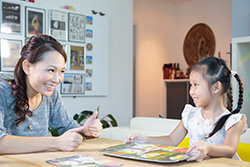Video
Development of Pre-primary Children 3-6 years old
Heading: Development of Pre-primary Children 3-6 years old
Dr. Rachel Cheng, Family Health Service of the Department of Health: A child's development is ongoing with certain sequences. What this means in general is that when children reach a certain age or developmental stage they will have corresponding advances or changes. A child's development is affected by innate genetic factors as well as by acquired experiences and their environment.
Narrator: To understand children's development we have to observe their performance in the following aspects physical, intellectual, language, affective and social skills. Remember, different areas of development are interrelated for instance, it is sometimes difficult to draw a line between language and intellectual functioning. It would be better for teachers to observe and interpret from an overall perspective.
Sub-heading: Physical Development – Gross and Fine Motor Skills
Sub-heading: Basic Movements (3 to 4 years old)
Scene: At the activity room of school, the teacher let the children step on the colourful footprints, they walked on the footprint steadily and happily. Two children at another activity room are playing ball with teacher. One of them is running to catch the rolling ball. A child is able to walk up and down stairs one foot per step.
Narrator: At the age of three to four years their movements will become steadier.
Sub-heading: Basic Movements (4 to 5 years old)
Scene: The children at school activity room, they are learning forward stepping, hopping back and forth with both legs, and forward hopping with single leg. The children are walking on stairs one foot per step without holding handrail.
Narrator: After turning four years old children gradually become more agile when they walk, run and jump.
Sub-heading: Basic Movements (5 to 6 years old)
Scene: In the activity room of school, the children are running smoothly. They can walk up and down stairs without holding handrail steadily.
Narrator: By the age of five they are more coordinated in all movements just like adults. They can walk up and down the stairs by placing one foot per step.
Sub-heading: Physical Activities (3 to 4 years old)
Scene: The children are queuing up to play slide, they are more coordinated in climbing up the steps.
Narrator: After three, gradually, their movement becomes more coordinated. They can propel a tricycle forward by using the pedals and also properly control its direction. They can kick a rolling ball as well as throw and catch a big ball.
Sub-heading: Physical Activities (4 to 5 years old)
Narrator: By the age of four to five they can walk on a balance beam. They aim more accurately when throwing a bean bag or a small ball.
Sub-heading: Physical Activities (4 to 5 years old)
Scene: Some children are climbing net at activity room. They are learning to master how to climb up and turn their body while climbing down the net.
Narrator: After turning five they become more agile. They can run and kick a ball at the same time and also bounce a ball with their hand.
Sub-heading: Eye-hand Coordination – Art and Craft (3 to 4 years old)
Scene: A girl is stacking up the eighth and ninth blocks. A child is using scissors to cut paper. Another two children are colouring. One is only scrabbling while another one is colouring a shape out of boundary.
Narrator: After three years old, these skills will be more refined. Yet, they cannot control their hands very well when colouring.
Sub-heading: Eye-hand Coordination – Art and Craft (4 to 5 years old)
Scene: A child is colouring a big circle and a square within boundary. Two girls are folding square papers into triangle. Another child has cut simple shape out and is using glue to stick on another paper.
Narrator: The four- to five-year-olds can apply different fine motor skills and creativity to produce various artwork and crafts.
Sub-heading: Eye-hand Coordination – Art and Craft (5 to 6 years old)
Scene: A child can colour a figure skillfully within boundary. Another child folds a square paper into a rectangle and then folds again to make a smaller square. Another child carefully cuts a smaller shape according to the lines.
Narrator: When they reach the age of five there is prominent improvement in their finger dexterity.
Sub-heading: Pencil Skills (3 to 4 year old)
Scene: In the classroom, during group activity time, some children are imitating different straight lines by using pencil on paper. Some children draw crosses on paper by using pencil.
Narrator: After three, then they draw by imitating different types of lines and simple shapes.
Sub-heading: Pencil Skills (4 to 5 years old)
Scene: A child draws a square and another child draws a triangle slowly. However, another girl manages to draw a square in faster speed.
Narrator: When they reach the age of four children can hold a pencil like an adult and draw more complex shapes.
Sub-heading: Pencil Skills (5 to 6 years old)
Scene: In the classroom, some children with age 5 to 6 are sitting around the table writing. They write simple English words such as mother, father, Chinese words such as 乘車 and numbers on paper by using pencil. A child erases a wrongly printed word by using an eraser. A girl uses right hand to hold pencil while uses left hand to hold a ruler to draw a straight line. A child is using pencil sharpener.
Narrator: Gradually, they can copy simple words… and also use other kinds of stationery when writing.
Sub-heading: Cognitive Development
Sub-heading: General Concepts (3 to 4 years old)
Scene: Some children are sitting and waiting for the instruction by the teacher. When they heard teacher said.
Teacher: Let's ask one more child to come out.
Scene: All the children hold up their hands. One girl is called up by the teacher to answer some questions.
Narrator: At the age of three they can tell you things about themselves.
Teacher: Tell us your name.
The girl: Chiu Chi Ying.
Teacher: And then tell us how old you are
The girl: I am four.
Teacher: So tell us, are you a boy or a girl?
The girl: A girl.
Scene: A child points to the colourful papers on the table and tells the colour of the paper.
The girl: This is red, blue and yellow
Narrator: They can tell the names of colours and show concepts of opposites.
Scene: Another girl points to the triangles, one big and one small, sticking on the whiteboard and says
The girl: This is big. This is small.
Scene: A boy puts a cup on a saucer, he also puts comb and mirror together. A child accurately put a bird behind a rabbit according to the instruction of a picture card. Another child draws a hand on a simple human figure by using crayon.
Narrator: They can match objects… put them in sequence… and also draw a simple human figure
Sub-heading: General Concepts (4 to 5 years old)
Narrator: After four years old, children are able to tell inconsistencies in pictures.
Scene: A teacher and a girl are in the classroom. The teacher points to the worksheet and ask the girl question
Teacher: Okay look here, where's the cow? What's wrong with it?
The girl: It has gone into the doghouse
Teacher: Oh, it's in the doghouse. What's wrong with the tortoise?
The girl: It's trying to climb the tree.
Teacher: Can they climb trees?
Scene: the teacher asks questions again, the girl shakes her head.
Narrator: or categorise different types of things
Scene: The teacher holds the card with words of dog, cow, goat and car written and asks the children questions.
Teacher: Which one is different, not the same?
Children: The Car.
Teacher: Why is the car different?
Children: because it is not an animal. It's not the same!
Teacher: That's right, the car is something different as it has wheels.
Scene: A girl uses crayon to draw a human figure with eyes, nose, mouth and hair. She also colours the hair and draws the hands for the figure.
Narrator: They can draw a human figure in more details.
Sub-heading: General Concepts (5 to 6 years old)
Scene: A girl arranges the toy buses according to their length.
Two girls arrange the round and square boxes according to their height. A girl arranges three cylinders according to their width.
Narrator: By the age of five, children have no problem in arranging things with difference in length…height… and width in correct order.
Sub-heading: Arithmetical Concepts (3 to 4 years old)
Scene: A group of children are sitting, clapping hands and counting together.
Narrator: Besides rote counting in sequence…
The children: 1, 2, 3, 4, 5, 6, 7, 8, 9, 10
Narrator: After three, they are able to grasp the concept of one-to-one counting and can also correctly count the number of objects.
Scene: A boy points and counts the circle shapes on the whiteboard slowly. Another girl also points to and counts the circles on the whiteboard accurately. The girl says : 1, 2, 3, 4 circles.
Sub-heading: Arithmetical Concepts (4 to 5 years old)
Narrator: When children reach the age of about four they begin to grasp the concept of time.
Scene: Two teachers and the children are learning time concept at the classroom. A teacher holds up a clock and ask the children questions.
Teacher: Can you tell me what children do at night?
Children: Sleeping.
Narrator: and begin to understand spatial relationships.
Teacher: Who is standing in front of the person in the blue top?
Scene: Follow the instruction of teacher, the boy chose the correct figure from the table.
Sub-heading: Arithmetical Concepts (5 to 6 years old)
Scene: A group of K3 children are having a class. The teacher is holding a calendar and asking questions.
Teacher: Okay, children can you all tell me again what date is today?
Narrator: After the age of five they can correctly use a calendar.
Children: 23rd of April, 2012.
Scene: The teacher continues to ask questions while holding the calendar.
Teacher: Okay. What day is it today?
Children: It's Monday.
Scene: Teacher holds a clock and asks the children questions.
Teacher: What time is it now?
The girl: Nine o'clock.
Scene: A child counts with his fingers, and calculate simple addition and subtraction on the worksheet.
Narrator: read time from a clock and perform simple addition and subtraction.
Sub-heading: Attention and Memory (3 to 4 years old)
Scene: Two teachers are telling story by holding a story book, a group of 3 to 4 years old kids listen attentively.
Narrator: When they reach age three they can attend to storytelling and play under the teacher's supervision.
Scene: A girl is hammering wooden pegs with a wooden hammer attentively.
Sub-heading: Attention and Memory (4 to 5 years old)
Scene: Two girls are sitting on the floor reading together, another girl is doing the worksheet attentively.
Narrator: After four years old, children can focus their attention on reading and doing a worksheet.
Sub-heading: Attention and Memory (5 to 6 years old)
Scene: In the classroom, a teacher holds a big story book reading the story with a group of children. A boy is standing next to the teacher retelling the story.
Narrator: From five onwards they can tell a story in their own words.
The boy: First, his friends come to see him then, after that, he says, \”I have a toothache\”. Then he says, \”I'm very thirsty. Can you give me some water? \”
Sub-heading: Word Recognition (3 to 4 years old)
Scene: A boy points to and reads the word cards on the plastic box.
Narrator: After the age of three children start to develop an interest in words.
A boy: \”Hand\” \”Up\” \”Mother\” \”Down\” .
Sub-heading: Word Recognition (4 to 5 years old)
Scene: The teacher holds up word cards for the children to read.
Narrator: Around the age of four children are able to recognise simple words.
Children: \”Cow\” \”Goat\”.
Scene: Teacher continues to ask questions.
Teacher: And this?
Children: \”Car\”.
Scene: The teacher holds a card with the word \” puppy\”, and asks the children questions.
Teacher: And what is this?
Children: \”puppy\”.
Scene: The teacher asks other related questions.
Narrator: and understand their meaning.
Teacher: How about cow? What's a cow?
Children: Animal
Scene: The teacher holds word card of \”goat\”.
Teacher: What is this?
Children: A goat is an animal.
Sub-heading: Word Recognition (5 to 6 years old)
Scene: One teacher and some children sitting in the classroom, she holds up several vocabulary cards for the children to read.
Narrator: After five years old they know more vocabulary.
Children: \”Children\”, \”Clothes\”, \”Classroom\”.
Scene: Teacher holds a card with the word \” Food \” and invites Calvin to read and explain, she also ask him other related questions.
Teacher: Okay, Calvin.
Calvin: Food that is something for us to eat.
Teacher: What kind of food do you know of?
Calvin: Apple, meat pie, donut, spaghetti.
Sub-heading: Language Development
Sub-heading: Verbal Comprehension (3 to 4 years old)
Scene: Two teachers are holding a big book and are telling story with a group of students in the classroom.
Narrator: After three they can understand more and more.
Teacher: Later, the Bear finds the Princess and what the Princess is doing. She's having something to eat…let's see…
Scene: Two boys are holding their balls while listening to the instructions of the teacher.
Narrator: including prepositions.
Teacher: Patrick, please put it into the basket.
Scene: After listening to the teacher's instruction, one of the boys put the ball into the basket.
Teacher: Lincoln, put it outside the basket.
Scene: After listening to the instruction, another boy put the ball outside the basket.
Sub-heading: Verbal Comprehension (4 to 5 years old)
Scene: Different toy cars are being lined up in front of some boys, the school bus toy car is put at the last of the line. The teacher is asking the children questions on the position of the toy cars.
Teacher: Which car is at the back, being the last?
Narrator: After four years old they can understand more abstract words.
Boy A: School bus.
Teacher: Which one is in the middle?
Boy B: The truck.
Scene: A group of students are in the classroom. There are two teachers with one holding a paper clock and asking the children questions on simple time concept.
Narrator: such as descriptions of spatial position and time
Teacher: What is Sidney doing in the morning?
Boy C: Wake up.
Scene: The teacher has turned the paper clock to nine. Another girl stands next to the teacher and is answering the questions with the other children.
Teacher: And what do children do at night?
Girl A: Sleeping.
Scene: Another is having class with a group of children, the teacher is asking question on the story about ant and cricket.
Narrator: They can also understand more complicated storylines.
Teacher: The Ant and the Cricket play together all day. Right, what happens when autumn arrives?
Girl B: The ants say, \”Winter's coming!\” They store up food and they're ready for the winter.
Sub-heading: Verbal Comprehension (5 to 6 years old)
Scene: Two children after listening to a teacher talking about a story of a lion. The teacher is asking them questions on the beginning and the end of the story. One of the girls is answering.
Teacher: At the beginning of the story, what happens?
Girl: The animal friends visit the lion.
Narrator: As a child's memory develops they can remember the order of events in a story.
Teacher: I see, what happens then at the end?
Girl: The lion says he is very hungry and wants to eat all his animal friends. Then all the animal friends run away.
Scene: The teacher is holding the big story book and continues to ask question about the story of the lion.
Narrator: and also make a logical guess at the ending of a story.
Teacher: Then all the animals run and run and run and finally escape. Alright. And that's the end of the story.
Scene: One of the boys is asking the teacher question.
Child: Why do they need to run away?
Teacher: Yes, why do they leave?
Scene: A girl and a boy are sitting and the girl is answering the question of the teacher.
Girl: Because the lion wants to eat them.
Scene: There is a paper box and some cards of Fuwa are being put in different positions of a table. Some children are sitting round the table and the teacher is asking them questions.
Narrator: They become more and more sophisticated in word understanding
Teacher: Who can show me which Fuwa is closest to the box?
Scene: The children are able to find the farthest and nearest Fuwa card accurately.
Children: These two!
Teacher: The farthest from the box who can show me?
Chidlren: These two!
Teacher: That's right!
Scene: There are two puzzle cards on the table, one with the back on top and the other with front on top. The teacher is asking the children questions.
Teacher: Which card shows the back? Which card shows the front?
Scene: The children follow the instruction and choose the cards accurately.
Scene: Teacher holds the calendar and points to the date of 23rd and ask the children questions.
Teacher: See, today the 23rd and it's Wednesday, okay. So, then what day was yesterday?
Scene: A group of children enthusiastically hold up their hands to answer question, one of the boy answers correctly.
Boy: Tuesday
Teacher: So, then when is the 24th?
Girl: Tomorrow
Sub-heading: Verbal Expression (3 to 4 years old)
Scene: A group of children are reciting nursery rhymes with movement.
Children: Together, we nod our heads, stretch our hands, bend our waists.
Narrator: After three, with their development they are able to use more vocabulary and longer sentences to express themselves.
Scene: One child use longer sentence to answer the teacher's question.
Boy A: Go back to school then hand in homework then after, we play with toys.
Scene: Some children sitting around the table, listening to the teacher and answering the teacher's questions.
Boy B: I see the little bird is flying up.
Teacher: An elephant. What does an elephant look like?
Boy B: Very long.
Teacher: What's very long?
Boy B: The nose.
Scene: One boy initiates to ask question.
Boy B: Teacher, what is an elephant?
Narrator: They like to ask questions. All these are children's characteristics at this stage of development.
Scene: Some children are sitting around and asking questions.
Boy A: Who are you, please? So what are you doing?
Boy B : Please, where is your head?
Sub-heading: Verbal Expression (4 to 5 years old)
Scene: A girl is answering the teacher's question.
Girl: Played at the park, played with friends. We were wet, went home and played again.
Narrator: When they reach four years old, they can even use more complex sentences to express themselves or recall details.
Scene: A teacher and some children are sitting in circle. The teacher is holding a big picture card asking the children questions. One girl is answering the teacher's question.
Girl: They are crickets and ants. Crickets are playing. Ants are moving their food home.
Teacher: Moving their food?
Girl: Yes.
Teacher: And then?
Girl: Then the ant says, \”Let's move the food together\” But the cricket says…. He says, \”Let us play together\” and the ants say, \”Nooo\”
Scene: On the table, there is a tortoise inside the plastic box.
Some children and a teacher are sitting round the table asking questions.
Girl: When will the tortoise's head come out from this again?
Boy: What do tortoises eat?
Teacher: What did you just ask?
Girl: How do tortoises eat?
Sub-heading: Verbal Expression (5 to 6 years old)
Scene: A teacher turns open the big story book, a girl stands next to the teacher telling story of the book.
Narrator: When children are about five, they can communicate with other people with no difficulty.
Girl: They're playing in the water. They made the floor all wet and there were many toys. Mammy saw them. She was very angry.
Scene: the teacher is asking the girl question.
Teacher: Really, then what would you say to mother?
Girl: I would say sorry to mum.
Scene: The girl goes back to her seat and continues answering questions.
Girl: When I go out to play and can't see my mother, then I start crying. Then when someone comes to me, I ask them, \”Who are you?\”
Narrator: They know how to speak in turn keeping on the topic.
Scene: A boy is answering teacher's questions.
Boy: You can't eat some types of butter. Only one type can be eaten which is the healthy butter.
Scene: Two boys continue to talk about butter.
Boy A: That's margarine.
Boy B: But some are also margarines, they are unhealthy. But there is a type of butter which is the healthiest of them all.
Scene: Some children sitting around and playing games. One boy grabs the other boy's blocks and the boy yells and tries to get back.
Narrator: When they are upset, they'll talk back and protest.
Boy: Ah! He's got mine! Um… that's not fair.
Sub-heading: Affective and Social Development
Sub-heading: Socialisation and Emotion (3 to 4 years old)
Scene: Two boys are playing a toy with wooden beads
Narrator: At the age of three they start to learn self-control.
Scene: Two boys are sitting on the floor. Their shoes get mixed up. One of the boys gets one shoe and tells the other boy.
Boy: This shoe is yours.
Scene: The other boy gets the other shoe and says.
Boy: This shoe is yours.
Narrator: They understand what belongs to them and what belongs to others.
Scene: Some children are lining up and taking turns to play a game.
Narrator: They know how to take turns with other children in play and be polite to others.
Scene: A girl is having meal with other children. A teacher asks the girl question.
Teacher: Tonie, do you want this?
Tonie: Yes. Thank you, Miss Wong
Teacher: Good girl
Sub-heading: Socialisation and Emotion (4 to 5 years old)
Scene: A group of children sitting round the table working on their worksheets in the classroom. Four girls sit on the floor, two by two reading books together.
Narrator: They engage in activities with self-discipline even without adult supervision.
Scene: Two girls are taking turns to play games.
Sub-heading: Socialisation and Emotion (5 to 6 years old)
Scene: Two children hold hands and go find a playmate to play together.
Narrator: Later, they will choose their playmates and cooperate when playing games.
Boy: Four of us, we need one more.
Scene: Some boys sit around a table and play table games together. They use a finger-guessing game to decide who play first.
Boy: Paper, Scissors, Stone.
Scene: When playing game, a boy stands up and explains to other children how to play.
Narrator: They are also able to agree on and follow the rules of games.
Boy: All three of you tied. Here 1, 2, 3, 4. You reach the blue,Go to the blue, Choose one card.
Scene: The children use dice to decide who will play first.
Boy: So, you're the second
Scene: A boy is playing chess and putting a chess-man for three steps.
Boy: 3…1, 2, 3.
Sub-heading: Self-care (3 to 4 years old)
Scene: Two children are eating with spoons. Another girl is using a handkerchief to clean her mouth. Two boys go to toilet by themselves. A girl puts on a jacket on her own and is trying to do buttoning. A girl pours water out from a plastic pot to a plastic cup.
Narrator: After three years old their self-care ability gradually improves.
Sub-heading: Self-care (4 to 5 years old)
Scene: Two boys are taking meals and can use chopsticks. A boy uses a tissue to clean his nose. Another boy turns on the tap and washes hands himself. A teacher is taking a boy brushing teeth in the toilet. Another boy turns on the tap, washes a plastic cup and uses tissue to dry up the cup. A girl puts the box of snack into her school bag herself.
Narrator: At the age of four most children can carry out simple self-care activities.
Sub-heading: Self-care (5 to 6 years old)
Scene: The children can use chopsticks skillfully when taking meal. Two boys brush teeth after taking meal. A girl uses a comb to comb her hair.
Narrator: At the age of five other than taking care of themselves they can also take care of others.
Scene: A girl is distributing bowls and chopsticks to other three children.
Narrator: The above developmental characteristics describe children in general. The pace of development is different in every child. When referring to the above video clips teachers also need to understand a child's development through day-to-day observation and your experience.
Scene: A group of children is playing slide. Three children are following the teacher's instruction to match the colour of different paper. Another teacher and some children are looking inside the plastic box. Four boys are playing chess.
Both nature and nurture affect every child's development. While nature is important in determining your child's capabilities and abilities, the role of a nurturing environment is of equal importance in your child's learning, as well as social and emotional development.
Development is a continuous process and has a certain sequence that children would go through. However, parents should remember that every child is unique and they have their own pace in development and vary in their abilities. For example, some may have attained their milestone of speech earlier, while others may be more advanced in physical agility than their peers. When you find your child is behind in certain abilities, instead of being over-alarmed, pay more attention and encourage him to try. Seek for assistance from your Maternal and Child Health Centre when you have concern.
What You Can Do to Help Your Child's Development (3 to 4 Years Old)
What Child Can Do
What you can do
I like to do active exercises
I can run, jump and climb
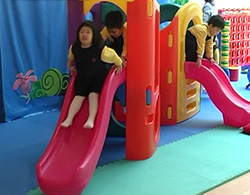
I can throw and catch bigger balls
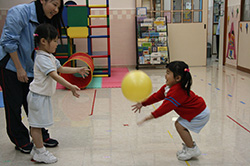
I can stand on one leg for a while
I can ride a tricycle
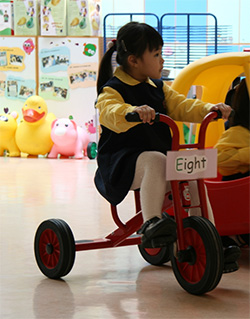
I need 3 hours of physical activities in a variety of ways, at least 60 minutes of which is moderate to vigorous intensity such as playing slides and swings, running, playing football. Encourage me to do some physical exercise daily to make me strong!

Take me to run around and explore in open spaces, e.g. playground, country park and zoo

My eye-hand coordination skills enable me to learn more
I learn to hold a pencil like adults
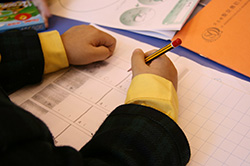
I can draw circles and squares
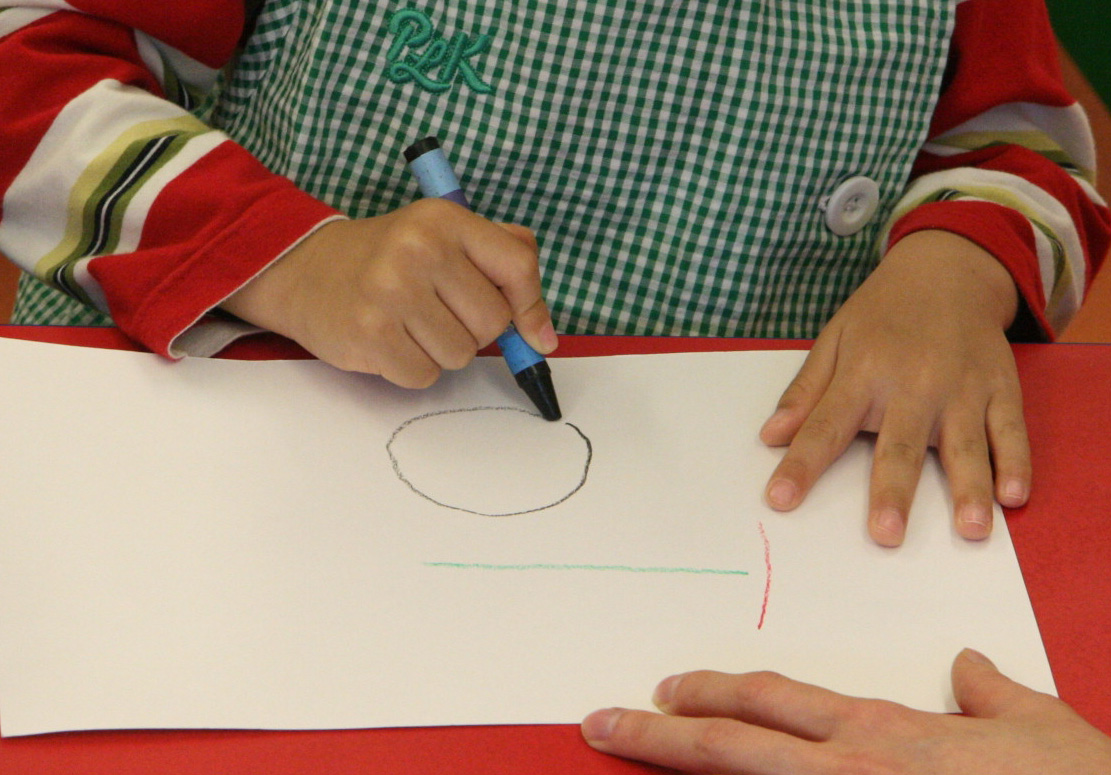
I can copy simple letters and characters comprising mainly of vertical and horizontal lines. e.g., 1, 十、口、 L、T
I can draw a human being (usually includes a head, legs and arms, eyes and mouth)

I try to cut paper strips with scissors
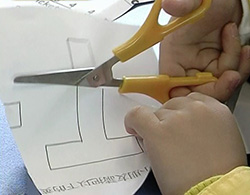
Play puzzles ( 6 – 8 pieces) with me
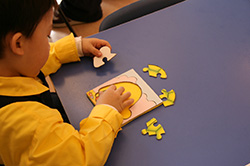
Let me have toys for creative play, such as mini tea-set, doll house, toy cars and garage, toy animals, building blocks and artcrafts like playdough and crayons
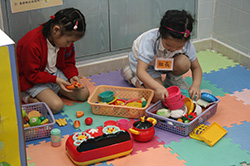
I am more independent
I usually stay dry at night
I can eat with a spoon skilfully

I can take off simple garments and unbutton myself, but I still need your help to put on my clothes properly

I can put on shoes with no shoelaces.
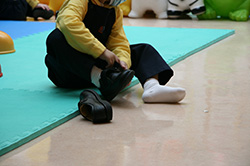
I can wash my hands

Encourage me to be independent in self-care activities
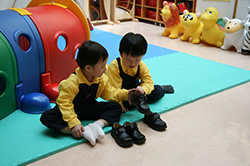
Let me do some simple household chores

I have developed more concepts
I like to ask “Why”, “Who”, and sometimes “How” questions
I understand the concept of quantity e.g., size, height, length and sequence
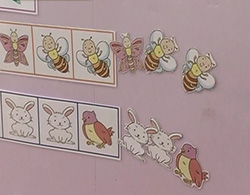
I can name a few colours
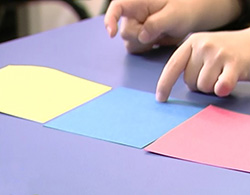
I can recite from 1 to 10 and count up to 3 to 4 objects
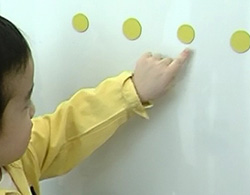
I begin to have simple concept of time in relation to my daily routine, e.g. after my brother has returned home from school, it's my time to go to the playground!
I cannot tell the difference of imagination and reality e.g. I may see unfamiliar shadows as scary monsters.
I may take the meaning of words only literally
I can only understand simple and concrete answers
Make use of daily life experiences to teach me abstract concepts such as size, colour and quantity
Find out answers together with me. By doing this, you are helping me to broaden my knowledge, satisfying my curiosity and teaching me how to learn

I have a much richer vocabulary
I can follow adult's daily instructions e.g., put the clothes into the laundry basket in the toilet
I love to listen to simple stories and I may ask you to tell my favourite story over and over again
I have a vocabulary of hundreds of words
I can use pronouns correctly, e.g. you, I, he
I can use simple sentences to express my needs and feelings
I start to talk with adults
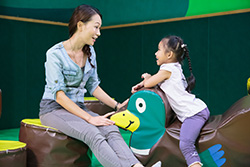
I can speak clearly although still cannot pronounce some words accurately. However, strangers can understand what I say
I can sing nursery rhymes with actions
Responding to my questions and asking me questions can enhance my learning and language development
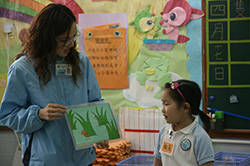
Teach me new words and expand my sentences by adding more words
Read a story and talk about it with me every day

I understand more about rules in social interaction
I enjoy pretend play and role play

I can play cooperative games with other children and follow game rules, such as taking turns and sharing toys
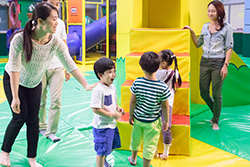
I begin to identify with my own sex, e.g. boys pretend to be fathers or brothers and girls pretend to be mothers or sisters in pretend play
I prefer friends of the same sex as me
Engage in pretend play with me and let me take the lead
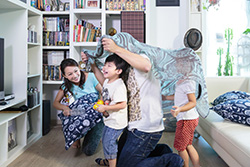
Make use of daily situations to teach me to get along and share with my friends
Teach me to take notice of others, e.g. wait for my turn until others finish speaking; speak softly in public, so that others won't be disturbed; ask for permission before touching or borrowing other's stuff
My emotions and feelings connect me with others
I start to control my behaviour but still need you to remind me to follow rules
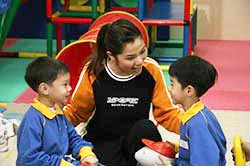
I can notice others' feelings and would try to comfort my friends by using words or actions
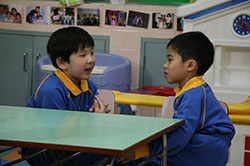
I begin to have the feeling of worrying
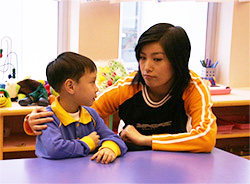
Spare some cosy time to talk with me every day
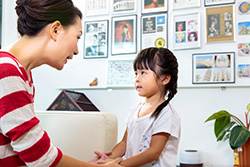
Listen to me patiently and encourage me to talk with your nods and smiles
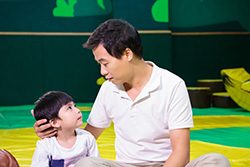
Help me to express my feelings and needs verbally. You can ask me, “You look upset, what's bothering you?”
Talk about the behaviours and feelings of the characters in stories with me. Tell me which behaviour you like and which should be discouraged.

What You Can Do to Help Your Child's Development (4 to 6 Years Old)
What Child Can Do
What you can do
I am stronger and can move fast
I can manage stairs and playground activities skilfully

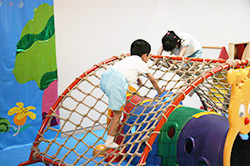
I can kick a rolling ball
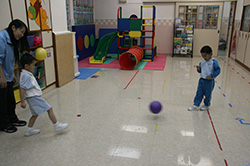
I can stand on one leg and keep balanced for 5 seconds or longer
I can hop forward on one foot for 2 to 3 metres
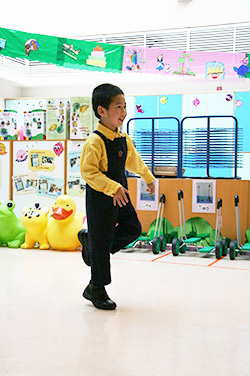
I can move my body with music in rhythm
I need 3 hours of physical activities in a variety of ways. Encourage and take me to the park or sports ground to do different physical exercises. It can make me strong and help to discharge my energy
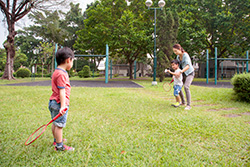
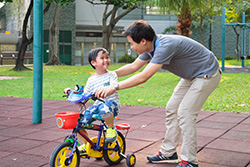
I am more skilful with my hands
I can build more elaborate models with building blocks
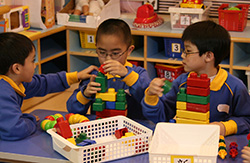
I can colour pictures neatly and staying within lines

I can draw a recognisable person with more features (commonly with head, eyes, nose, mouth, body, limbs with hands and feet)
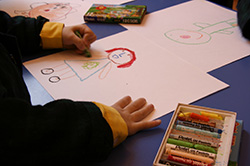
I can write numerals, alphabets and simple Chinese characters, e.g., 1 – 20, A-Z, 水, 車, 媽, 吃
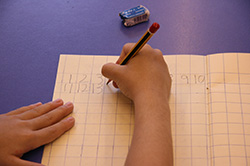
I can do simple art work involving cutting with scissors, applying glue and sticking objects into position
Let me play construction toys e.g. robots, building blocks, art and craft materials e.g. drawing, or even household objects, to enhance my creativity
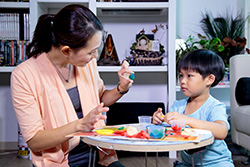

Have make-believe play with me, e.g. doll house, toy cars and garage, animals and puppets

I can think and learn more
I start to maintain attention to complete a simple task
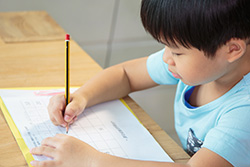
I will ask the meaning of new words heard
I can do simple addition and subtraction within 10
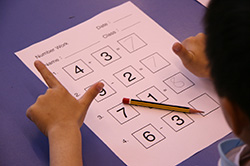
I can name 10 or more colours
I can understand basic concept of time, e.g. morning and afternoon, today and tomorrow, and weekdays and holidays.
I begin to reason from my point of view, but I may not be able to consider several possible factors at the same time
I can tell fantasy from reality
Set up daily routine with me according to my ability. Help me learn to finish homework by myself

Give daily opportunities for me to ask questions, think and apply knowledge. e.g. count the number of persons present, try to figure out solutions for problems
Spend more time with me after school. Let me explore and learn in different settings, e.g. park, zoo, library and museum
I can communicate well
I can speak clearly and fluently with adult sentence structure and grammar
When I am talking with others, I can respond accordingly
I can tell you my name, age and address
I can retell some scenes of the story that I have just heard

I can give a logical account of what has happened recently
I love jokes and riddles
Talk with me more, listen to me and respond appropriately
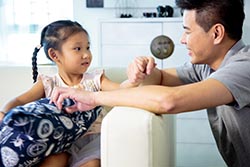
Read with me every day and talk about the story
Tell me jokes and riddles
I have better social participation
I can take part in group play requiring me to take turns and follow rules. I can play cooperatively with friends most of the time
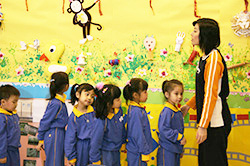
I can follow social rules, e.g. asking for permissions and returning borrowed stuff
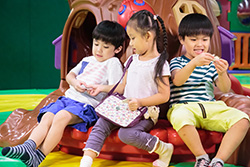
I enjoy pretend play with my friends, e.g. pretending to be parents, policeman and superheroes
I can tell the names of most of my classmates and choose friends that I like
I don't want to be different from my friends
I am aware of the role characteristics and physical differences between males and females
Let me play with my friends
Be a role model of appreciating and respecting others
Teach me social manners to get along with others, including not touching and peeking at others' private parts
Try to answer my questions about gender differences and talk about sex education
Teach me to follow public regulations, e.g. pay the right amount of fares for my age; no eating and drinking in public transport
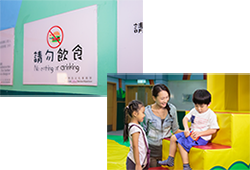
Model civic ethics for me, including not taking advantage of others (e.g. not jumping queues), not taking more than one needs (e.g. using only just enough paper towels for drying hands), and not intruding on others' privacy and rights (e.g. turn down the music level)
Show me how to love the environment and treasure the resources on earth
Nurturing Virtues and Values in Children
Title: Nurturing Virtues and Values in Children
Narrator: Nurturing virtues and values in children
Scene: When entering children's playroom, Mrs. Lee reminds Kiki to take off her shoes and put them on the shelf. Mr. Wong teaches Hinz to take turns if he wants to play. Chris jumps the queue for playing on the slide; Mrs. Wong stops him and asks him to queue up.
Narrator: It is essential to start nurturing virtues and values in young children so that they can do the right things and be nice to people around them. It will also contribute to their success in the future.
Narrator: From 2 years old, children learn to think from others' points of view. We can make use of every opportunity in daily life to develop such ability according to their developmental level. Being their role model, it is important in instilling them with good virtues and values.
Heading: Respect Others
Narrator: Respect others
Scene: The Wongs meet Mrs Lee and her daughter, Kiki, in the children's playroom. They greet each other.
Narrator: Just like Mr. and Mrs. Wong, they respect people and are caring and polite. They greet their neighbours, Mrs. Lee and her daughter, at the children's playroom with their son.
Scene: When Mrs. Lee and Mrs. Wong are chatting, Chris pulls Mrs. Wong's hand. Mr. Wong asks Chris to stop.
Narrator: Chris wants to go and keeps pulling his Mum's hand while she is chatting with Mrs. Lee.
Narrator: Seeing Chris keep pulling Mum's hand, Mr. Wong tells Chris to respect others and to wait until they finish talking.
Heading: Care and Empathy
Narrator: Care and empathy
Scene: Kiki and Chris are playing in the playroom while their parents are chatting nearby. Hinz tripped over and fell down.
Narrator: Kiki and Chris are playing in the playroom. Suddenly, a boy trips over and falls down.
Scene: Chris laughs at the boy but Kiki offers help to him.
Narrator: Chris laughs at the boy but Kiki offers help to him.
Scene: Mrs. Lee smiles at Kiki and gives her a thumbs-up.
Narrator: Mrs. Lee smiles at Kiki and gives her a thumbs-up.
Scene: Mr. Wong talks with Chris.
Narrator: Mr. Wong asks Chris if he would like others to laugh at him if he is the one who trips.
Narrator: Chris shakes his head in response.
Heading: Sharing and Cooperation
Narrator: Sharing and cooperation
Scene: Chris, Kiki and Hinz have lots of fun. Kiki is sharing her stickers with them.
Narrator: Kiki shares her stickers with Chris and Hinz.
Narrator: The boys are so happy when they receive the stickers.
Narrator: It is good that children learn to share.
Heading: Cultivate Social Responsibilities
Narrator: Cultivate social responsibilities
Scene: Chris takes out some snacks from his pocket. Kiki and Mrs. Lee tell him that he should not eat in the playroom.
Narrator: Chris takes out some snacks from his pocket to eat in the playroom. Kiki and Mrs. Lee stop him and draw his attention to the sign of ‘No eating'.
Narrator: Helping children to obey rules in public places is important.
Heading: Develop Self-control
Narrator: Develop self-control
Scene: Chris, Kiki and Hinz are playing together.
Narrator: Children have difficulties in controlling their impulses and lose their temper easily. One thing you can do, is to help your child develop her self-control.
Scene: Kiki has just got down from the slide. Mrs. Lee tells her that it is time to go home.
Narrator: While Kiki is having a wonderful time in the playroom, Mrs Lee tells Kiki it's time to go home.
Scene: Kiki refuses to go home. She starts to throw a tantrum and stamp her feet.
Narrator: Kiki refuses to leave. She keeps stamping her feet.
Scene: Mrs. Lee takes her aside and teaches her to take deep breaths to calm herself down.
Narrator: Mrs. Lee takes her aside and teaches her to take deep breaths to calm herself down.
Scene: Mrs. Lee praises Kiki for calming down.
Narrator: Finally, Kiki calms down, and Mrs. Lee praises her. Then, they go home together.
Scene: Children are playing orderly in the children playroom.
Narrator: To foster your child's self-control, your persistent effort with the child is important!
End Shot: Department of Health logo
The Department of Health owns the copyright of this digital video.
This digital video is produced solely for non-commercial use.
It should not be rented, sold or otherwise used for profit-making purposes.
Produced in 2015
I can control and express my feelings
I can control my emotions and express my needs in words
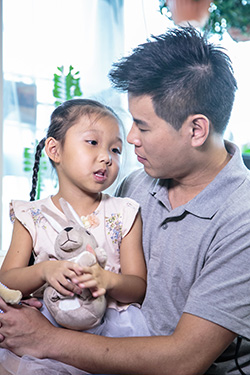
I begin to understand and ask about others' thought and feelings. I may also try to hide mine too
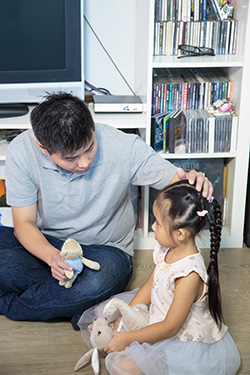
Spend some time with just you and me chatting. Listen when I tell you about things exciting or worrying
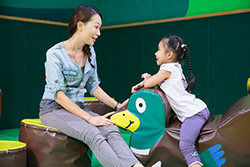
Help me to express my feelings, needs and thoughts in words

Let me have chances to choose with your guidance
Show me how to think in others' shoes, e.g. you may tell me, “If you tripped over and Ron laughs at you, how would you feel? So, how do you want Ron to treat you?”
Teach me to be responsible for my acts and encourage me to admit my mistakes and remedy for my wrongdoings, e.g. take corrective actions after apologising
Show me what commitment is by demonstrating how to do one's best and complete what one has started.
Remember to set realistic expectations according to my abilities. Guide me if needed and, most importantly, encourage and praise me
